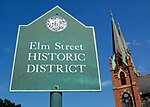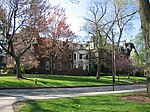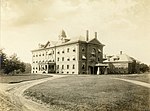Calvin Coolidge House
Buildings and structures in Northampton, MassachusettsCalvin CoolidgeHouses completed in 1901Houses in Hampshire County, MassachusettsHouses on the National Register of Historic Places in Massachusetts ... and 2 more
National Register of Historic Places in Hampshire County, MassachusettsPresidential homes in the United States

The Calvin Coolidge House is a historic house located at 19-21 Massasoit Street in Northampton, Massachusetts. Built in 1901, it is most historically significant as the home of the 30th president of the United States, Calvin Coolidge between 1906 and 1930, the height of his political career. It was listed on the National Register of Historic Places on December 12, 1976.
Excerpt from the Wikipedia article Calvin Coolidge House (License: CC BY-SA 3.0, Authors, Images).Calvin Coolidge House
Massasoit Street, Northampton
Geographical coordinates (GPS) Address Nearby Places Show on map
Geographical coordinates (GPS)
| Latitude | Longitude |
|---|---|
| N 42.324722222222 ° | E -72.646944444444 ° |
Address
Massasoit Street 13
01063 Northampton
Massachusetts, United States
Open on Google Maps







